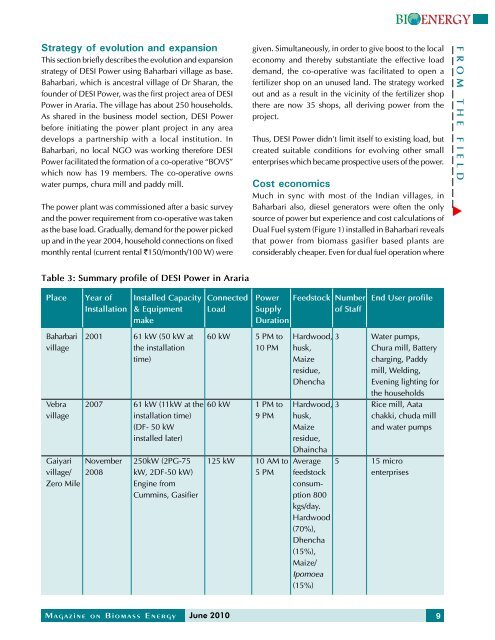issue 4 - United Nations Development Programme
issue 4 - United Nations Development Programme
issue 4 - United Nations Development Programme
You also want an ePaper? Increase the reach of your titles
YUMPU automatically turns print PDFs into web optimized ePapers that Google loves.
Strategy of evolution and expansion<br />
This section briefly describes the evolution and expansion<br />
strategy of DESI Power using Baharbari village as base.<br />
Baharbari, which is ancestral village of Dr Sharan, the<br />
founder of DESI Power, was the first project area of DESI<br />
Power in Araria. The village has about 250 households.<br />
As shared in the business model section, DESI Power<br />
before initiating the power plant project in any area<br />
develops a partnership with a local institution. In<br />
Baharbari, no local NGO was working therefore DESI<br />
Power facilitated the formation of a co-operative “BOVS”<br />
which now has 19 members. The co-operative owns<br />
water pumps, chura mill and paddy mill.<br />
The power plant was commissioned after a basic survey<br />
and the power requirement from co-operative was taken<br />
as the base load. Gradually, demand for the power picked<br />
up and in the year 2004, household connections on fixed<br />
monthly rental (current rental `150/month/100 W) were<br />
given. Simultaneously, in order to give boost to the local<br />
economy and thereby substantiate the effective load<br />
demand, the co-operative was facilitated to open a<br />
fertilizer shop on an unused land. The strategy worked<br />
out and as a result in the vicinity of the fertilizer shop<br />
there are now 35 shops, all deriving power from the<br />
project.<br />
Thus, DESI Power didn’t limit itself to existing load, but<br />
created suitable conditions for evolving other small<br />
enterprises which became prospective users of the power.<br />
Cost economics<br />
Much in sync with most of the Indian villages, in<br />
Baharbari also, diesel generators were often the only<br />
source of power but experience and cost calculations of<br />
Dual Fuel system (Figure 1) installed in Baharbari reveals<br />
that power from biomass gasifier based plants are<br />
considerably cheaper. Even for dual fuel operation where<br />
FROM THE FIELD<br />
Table 3: Summary profile of DESI Power in Araria<br />
Place Year of Installed Capacity Connected Power Feedstock Number End User profile<br />
Installation & Equipment Load Supply of Staff<br />
make<br />
Duration<br />
Baharbari 2001 61 kW (50 kW at 60 kW 5 PM to Hardwood, 3 Water pumps,<br />
village the installation 10 PM husk, Chura mill, Battery<br />
time) Maize charging, Paddy<br />
residue,<br />
mill, Welding,<br />
Dhencha<br />
Evening lighting for<br />
the households<br />
Vebra 2007 61 kW (11kW at the 60 kW 1 PM to Hardwood, 3 Rice mill, Aata<br />
village installation time) 9 PM husk, chakki, chuda mill<br />
(DF- 50 kW Maize and water pumps<br />
installed later)<br />
residue,<br />
Dhaincha<br />
Gaiyari November 250kW (2PG-75 125 kW 10 AM to Average 5 15 micro<br />
village/ 2008 kW, 2DF-50 kW) 5 PM feedstock enterprises<br />
Zero Mile Engine from consum-<br />
Cummins, Gasifier ption 800<br />
kgs/day.<br />
Hardwood<br />
(70%),<br />
Dhencha<br />
(15%),<br />
Maize/<br />
Ipomoea<br />
(15%)<br />
Magazine on Biomass Energy June 2010 9
















